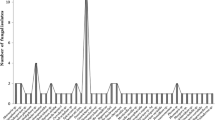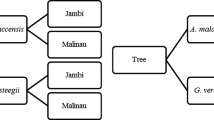Abstract
Aquilaria malaccensis, the resinous agarwood, is highly valued in the perfumery and medicinal industry. The formation of fragrant agarwood resin inconsistently by various fungi is still not clearly understood. The current study investigated the agarwood quality and fungal diversity in artificially inoculated and naturally infected A. malaccensis. The chemical analysis of volatile compounds of agarwood was performed using the Solid Phase Micro Extraction (SPME) method, and the identification of fungi was made through a morphological observation using a light microscope. Gas chromatography analysis revealed the presence of essential compounds related to high-quality agarwood, such as 4-phenyl-2-butanone, β-selinene, α-bulnesene, and agarospirol in both artificially inoculated and naturally infected agarwood but with some differences in the abundance. Further studies on the fungi associated with agarwood volatile compounds formation showed a total of ten fungal group isolates, which were identified based on morphological and molecular studies. The study revealed that agarwood from both artificial and natural sources were naturally infected with Fusarium, Botryosphaeria, Aspergillus, Schizophyllum, Phanerochaete, Lasiodiplodia, Polyporales, and Ceriporia species. This study has offered a potential opportunity to research further the promising development of fungal strains for artificial inducement of high-quality agarwood formation from A. malaccensis trees.

Similar content being viewed by others
Data Availability
All data generated or analysed during this study are included in this published article.
References
Rasool S., Mohamed R. (2016) Understanding Agarwood Formation and Its Challenges. In: Mohamed R (eds) Agarwood Tropical Forestry Springer, Singapore Doi: https://doi.org/10.1007/978-981-10-0833-7_3
Chhipa H, Kaushik N (2017) Fungal and bacterial diversity isolated from Aquilaria malaccensis tree and soil, induces agarospirol formation within 3 months after artificial infection. Front Microbiol 8:1286. https://doi.org/10.3389/fmicb.2017.01286
Faizal A, Esyanti RR, Aulianisa EN et al (2017) Formation of agarwood from Aquilaria malaccensis in response to inoculation of local strains of Fusarium solani. Trees 31:189–197. https://doi.org/10.1007/s00468-016-1471-9
Turjaman M., Hidayat A., Santoso E. (2016) Development of Agarwood Induction Technology Using Endophytic Fungi. In: Mohamed R. (eds) Agarwood. Tropical Forestry. Springer, Singapore https://doi.org/10.1007/978-981-10-0833-7_4
Barden A, Anak NA, Mulliken T, Song M. Heart of the matter: agarwood use and trade and CITES implementation for Aquilaria malaccensis. TRAFFIC International, Cambridge, UK. 2000 Aug.
Bhuyar P, Rahim MH, Sundararaju S, Maniam GP, Govindan N (2020) Antioxidant and antibacterial activity of red seaweed Kappaphycus alvarezii against pathogenic bacteria. Global J Environ Sci Manag 6(1):47–58. https://doi.org/10.22034/GJESM.2020.01.04
Jayachandran KS, Sekar I, Parthiban KT, Amirtham D, Suresh KK (2015) Analysis of different grades of agarwood (Aquilaria malaccensis Lamk.) oil through GC-MS. Indian Journal of Natural Products and Resources (IJNPR) 5(1):44–47
Chua LS (2008) Agarwood (Aquilaria malaccensis) in Malaysia. Forest Research Institute Malaysia
Bhuiyan MN, Begum J, Bhuiyan MN (2009) Analysis of essential oil of eaglewood tree (Aquilaria agallocha Roxb) by gas chromatography mass spectrometry. Bangladesh J Pharmacol 4(1):24–28. https://doi.org/10.3329/bjp.v4i1.85
Premalatha K, Kalra AJ (2013) Molecular phylogenetic identification of endophytic fungi isolated from resinous and healthy wood of Aquilaria malaccensis, a red listed and highly exploited medicinal tree. Fungal Ecol 6(3):205–211. https://doi.org/10.1016/j.funeco.2013.01.005
Mohamed R, Jong PL, Zali MS (2010) Fungal diversity in wounded stems of Aquilaria malaccensis. Fungal Diversity 43:67–74. https://doi.org/10.1007/s13225-010-0039-z
Monggoot S, Kulsing C, Wong YF et al (2018) Incubation of aquilaria subintegra with microbial culture supernatants enhances production of volatile compounds and improves quality of agarwood oil. Indian J Microbiol 58:201–207. https://doi.org/10.1007/s12088-018-0717-1
Bhuyar P, Rahim MHA, Maniam GP et al (2020) Exploration of bioactive compounds and antibacterial activity of marine blue-green microalgae (Oscillatoria sp) isolated from coastal region of west Malaysia. SN Appl. Sci. 2:1906. https://doi.org/10.1007/s42452-020-03698-8
Ferreira JH, Matthee FN, Thomas AC (1991) Biological control of Eutypa lata on grapevine by an antagonistic strain of Bacillus subtilis. Phytopathology 81(3):283–287
Ramli AN, Hamid HA, Zulkifli FH, Zamri N, Bhuyar P, Manas NH (2021) Physicochemical properties and tenderness analysis of bovine meat using proteolytic enzymes extracted from pineapple (Ananas comosus) and jackfruit (Artocarpus heterophyllus) by-products. J Food Process Preserv 45(11):e15939. https://doi.org/10.1111/jfpp.15939
Ramli AN, Sukri NA, Azelee NI, Bhuyar P (2021) Exploration of antibacterial and antioxidative activity of seed/peel extracts of Southeast Asian fruit Durian (Durio zibethinus) for effective shelf-life enhancement of preserved meat. J Food Process Preserv 45(9):e15662. https://doi.org/10.1111/jfpp.15662
Chehri K, Salleh B, Zakaria L (2015) Morphological and phylogenetic analysis of Fusarium solani species complex in Malaysia. Microb Ecol 69(3):457–471. https://doi.org/10.1007/s00248-014-0494-2
Ploetz RC (2015) Fusarium wilt of banana. Phytopathology 105:1512–1521
Norhayati M, Erneeza MH, Kamaruzaman S (2016) Morphological, pathogenic and molecular characterization of Lasiodiplodia theobromae A causal pathogen of black rot disease on kenaf seeds in Malaysia. Int J Agricult Biol 18(1):80–85. https://doi.org/10.17957/IJAB/15.0065
Zhang Y, Liu HX, Li WS, Tao MH, Pan QL, Sun ZH, Ye W, Li HH, Zhang WM (2017) 2-(2-phenylethyl) chromones from endophytic fungal strain Botryosphaeria rhodina A13 from Aquilaria sinensis. Chinese Herbal Medicines 9(1):58–62. https://doi.org/10.1016/S1674-6384(17)60076-5
Mishra A, Gond SK, Kumar A, Sharma VK, Verma SK, Kharwar RN, Sieber TN (2012) Season and tissue type affect fungal endophyte communities of the Indian medicinal plant Tinospora cordifolia more strongly than geographic location. Microb Ecol 64(2):388–398. https://doi.org/10.1007/s00248-012-0029-7
Mohamed R, Jong PL, Nurul Irdayu I (2014) Succession patterns of fungi associated to wound-induced agarwood in wild Aquilaria malaccensis revealed from quantitative PCR assay. World J Microbiol Biotechnol 30:2427–2436. https://doi.org/10.1007/s11274-014-1668-2
Sales AC, Yoshizawa T (2005) Updated profile of aflatoxin and Aspergillus section Flavi contamination in rice and its byproducts from the Philippines. Food Addit Contam 22(5):429–436. https://doi.org/10.1080/02652030500058387
Singh PK, Kathuria S, Agarwal K, Gaur SN, Meis JF, Chowdhary A (2013) Clinical significance and molecular characterization of nonsporulating molds isolated from the respiratory tracts of bronchopulmonary mycosis patients with special reference to basidiomycetes. J Clin Microbiol 51(10):3331–3337. https://doi.org/10.1128/JCM.01486-13
Teoh Y, Mashitah MD, Salmiah U (2017) Production of biomass by Schizophyllum commune and its antifungal activity towards rubberwood-degrading fungi. Sains Malaysiana 46(1):123–128
Zulkarnain A, Bahrin EK, Ramli N et al (2018) Alkaline hydrolysate of oil palm empty fruit bunch as potential substrate for biovanillin production via two-step bioconversion. Waste Biomass Valor 9:13–23. https://doi.org/10.1007/s12649-016-9745-4
Sultan S, Sun L, Blunt JW, Cole AL, Munro MH, Ramasamy K, Weber JF (2014) Evolving trends in the dereplication of natural product extracts. 3: further lasiodiplodins from Lasiodiplodia theobromae, an endophyte from Mapania kurzii. Tetrahedron Lett 55(2):453–455. https://doi.org/10.1016/j.tetlet.2013.11.060
El-Fadaly HM, El-Kadi SM, Hamad MN, Habib AA (2015) Isolation and identification of egyptian ras cheese (Romy) contaminating fungi during ripening period. J Microbiol Res 5:1–10
Krull R, Wucherpfennig T, Esfandabadi ME, Walisko R, Melzer G, Hempel DC, Kampen I, Kwade A, Wittmann C (2013) Characterization and control of fungal morphology for improved production performance in biotechnology. J Biotechnol 163(2):112–123. https://doi.org/10.1016/j.jbiotec.2012.06.024
Nasution F, Theanhom AA, Bhuyar P, Chumpookam J (2021) Genetic diversity evaluation in wild Muntingia calabura L. based on Random Amplified Polymorphic DNA (RAPD) markers. Gene Reports 25:101335. https://doi.org/10.1016/j.genrep.2021.101335
Raja HA, Miller AN, Pearce CJ, Oberlies NH (2017) Fungal identification using molecular tools: a primer for the natural products research community. J Nat Prod 80(3):756–770. https://doi.org/10.1021/acs.jnatprod.6b01085
Schoch CL, Seifert KA, Huhndorf S, Robert V, Spouge JL, Levesque CA, Chen W (2012) Fungal Barcoding Consortium Nuclear ribosomal internal transcribed spacer (ITS) region as a universal DNA barcode marker for Fungi. Proc Natl Acad Sci 109(16):6241–6246. https://doi.org/10.1073/pnas.1117018109
Min XJ, Hickey DA (2007) Assessing the effect of varying sequence length on DNA barcoding of fungi. Mol Ecol Notes 7(3):365–373. https://doi.org/10.1111/j.1471-8286.2007.01698.x
Ismail N, Ali NA, Jamil M, Rahiman MH, Tajuddin SN, Taib MN (2014) A review study of agarwood oil and its quality analysis. Jurnal Teknologi. https://doi.org/10.11113/jt.v68.2419
Tajuddin SN, Yusoff MM (2010) Chemical composition of volatile oils of Aquilaria malaccensis (Thymelaeaceae) from Malaysia. Natural Product Commun 5(12):1934. https://doi.org/10.1177/1934578X1000501229
Zhang XL, Liu YY, Wei JH, Yang Y, Zhang Z, Huang JQ, Chen HQ, Liu YJ (2012) Production of high-quality agarwood in Aquilaria sinensis trees via whole-tree agarwood-induction technology. Chin Chem Lett 23(6):727–730. https://doi.org/10.1016/j.cclet.2012.04.019
Liu Y, Chen H, Yang Y, Zhang Z, Wei J, Meng H, Chen W, Feng J, Gan B, Chen X, Gao Z (2013) Whole-tree agarwood-inducing technique: an efficient novel technique for producing high-quality agarwood in cultivated Aquilaria sinensis trees. Molecules 18(3):3086–3106. https://doi.org/10.3390/molecules18033086
Ponzio C, Gols R, Pieterse CM, Dicke M (2013) Ecological and phytohormonal aspects of plant volatile emission in response to single and dual infestations with herbivores and phytopathogens. Funct Ecol 27(3):587–598. https://doi.org/10.1111/1365-2435.12035
Ishihara M, Tsuneya T, Uneyama K (1993) Fragrant sesquiterpenes from agarwood. Phytochemistry 33(5):1147–1155. https://doi.org/10.1016/0031-9422(93)85039-T
Wetwitayaklung P, Thavanapong N, Charoenteeraboon J (2009) Chemical constituents and antimicrobial activity of essential oil and extracts of heartwood of Aquilaria crassna obtained from water distillation and supercritical fluid carbon dioxide extraction. Science, Engineering and Health Studies. https://doi.org/10.14456/sustj.2009.3
Naef R (2011) The volatile and semi-volatile constituents of agarwood, the infected heartwood of Aquilaria species: a review. Flavour Fragr J 26(2):73–87. https://doi.org/10.1002/ffj.2034
Ismail N, Rahiman MH, Taib MN, Ibrahim M, Zareen S, Tajuddin SN. Observation on SPME different headspace fiber coupled with GC-MS in extracting high quality agarwood chipwood. In2016 IEEE International Conference on Automatic Control and Intelligent Systems (I2CACIS) 2016 Oct 22 (pp. 214–218). IEEE. https://doi.org/10.1109/I2CACIS.2016.7885317
Gratani L (2014) Plant phenotypic plasticity in response to environmental factors. Adv Botany 22:2014
Gouinguené SP, Turlings TC (2002) The effects of abiotic factors on induced volatile emissions in corn plants. Plant Physiol 129(3):1296–1307. https://doi.org/10.1104/pp.001941
Ramli ANM, Manap NWA, Bhuyar P et al (2020) Passion fruit (Passiflora edulis) peel powder extract and its application towards antibacterial and antioxidant activity on the preserved meat products. SN Appl Sci 2:1748. https://doi.org/10.1007/s42452-020-03550-z
Acknowledgements
We acknowledged the Bio Aromatic Research Centre of Excellent and Faculty of Industrial Sciences & Technology, University Malaysia Pahang, to carry out this study. This project was funded by Universiti Malaysia Pahang (RDU182207-1).
Funding
This work was supported by Universiti Malaysia Pahang (Grant Number: RDU182207-1).
Author information
Authors and Affiliations
Contributions
Conceptualization: SY, ANMR; Methodology: SY, AWA; Formal analysis and investigation: SY, SNT; Writing—original draft preparation: SY, AWA; Writing—review and editing: SY, PB, HAH; Funding acquisition: ANMR; Resources: ANMR; Supervision: ANMR.
Corresponding author
Ethics declarations
Conflict of interest
The authors have no relevant financial or non-financial interests to disclose.
Ethical Approval
Not applicable.
Consent for Publication
I, Aizi Nor Mazila Ramli hereby declare that I participated in the study and in the development of the manuscript titled “Production of volatile compounds by various fungi in artificially inoculated and naturally infected Aquilaria malaccensis”. I have read the final version and give my consent for the article to be published in Current Microbiology.
Additional information
Publisher's Note
Springer Nature remains neutral with regard to jurisdictional claims in published maps and institutional affiliations.
Supplementary Information
Below is the link to the electronic supplementary material.
Rights and permissions
About this article
Cite this article
Ramli, A.N.M., Yusof, S., Bhuyar, P. et al. Production of Volatile Compounds by a Variety of Fungi in Artificially Inoculated and Naturally Infected Aquilaria malaccensis. Curr Microbiol 79, 151 (2022). https://doi.org/10.1007/s00284-022-02840-6
Received:
Accepted:
Published:
DOI: https://doi.org/10.1007/s00284-022-02840-6




